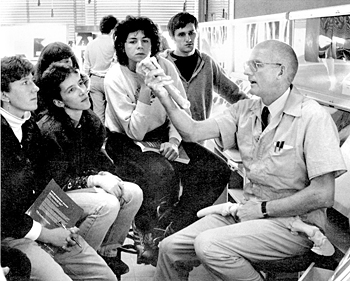FACULTY
Faculty Legends: Alexander de Lahunta

Alexander de Lahunta See larger image
Looking back on his 45 years at the College of Veterinary Medicine, Alexander de Lahunta, DVM ’58, Ph.D. ’63, believes he “just happened to be at the right place at the right time.” And what a time it has been for “Dr. D.,” as he is fondly called by colleagues and students.
“Dr. de Lahunta is a pioneer in veterinary neurology, renowned worldwide for his rigorous scholarship and his initial identification of many neurological diseases,” says Michael I. Kotlikoff, the Austin O. Hooey Dean of Veterinary Medicine. “Fundamentally, though, he epitomized the term ‘teacher’ in its broadest sense. In rounds, neurological exams, in the lecture hall, and in one-on-one examinations, he communicated an extraordinary passion for knowledge and inspired generations of veterinarians.”
Starting as an assistant professor upon earning his Ph.D. at the college, de Lahunta has fulfilled many vital roles: full professor (1973); chief of the medical and surgical sections of the Veterinary Medical Teaching Hospital, now the Cornell University Hospital for Animals (1975-76); hospital director (1976-82); chairman of the then-newly established Department of Clinical Sciences (1977-86) and the Department of Anatomy (1986-91); and the James Law Professor of Anatomy (1992).
His laurels are many. In 2000 he received the Robert W. Kirk Award from the American College of Veterinary Internal Medicine. By his retirement in 2005, he had received the college’s Norden Distinguished Teacher Award four times and earned honorary membership to the American College of Veterinary Pathologists and the Royal College of Veterinary Surgeons. In 2008 the College of Veterinary Medicine’s Alumni Association recognized him with the Daniel Elmer Salmon Award.
A wide-ranging scholar, de Lahunta has published more than 250 scientific articles and written the seminal textbook “Veterinary Neuroanatomy and Clinical Neurology.” He co-authored several other books and, this year, co-authored the fourth edition of “Miller’s Anatomy of the Dog” with his lifelong mentor, Dr. Howard Evans ’44, Ph.D. ’50.
Of his accomplishments, de Lahunta claims his greatest achievement was “successfully teaching veterinary students,” many of whom have pursued academic or clinical careers in clinical neurology. Responsible for core courses from anatomy to neuropathology, de Lahunta incorporated teaching into all of his endeavors, including his weekly noontime neurology and neuropathology rounds and his famous 2 a.m. consultations – open to anyone interested in observing the doctor perform neurologic examinations. By collaborating with colleagues across departments, he also established the college’s world-renowned clinical neurology program.
“Dr. D. is so humble and yet so accomplished, and his hard work and dedication – as well as his care for the patient and their owners and his respect for everyone around him – won people over,” explains Eric Glass ’89, DVM ’95, a former student now practicing neurology and neurosurgery at the Red Bank Veterinary Hospital in New Jersey. Glass himself became a close collaborator of de Lahunta’s, co-writing the third edition of “Veterinary Neuroanatomy and Clinical Neurology” with him in 2008. “His whole life is dedicated to the pursuit of training veterinarians,” Glass says.
Now 79 years old, de Lahunta still enlightens veterinarians through guest lectures, including one at Red Bank Veterinary Hospital last April. “There must have been 150 practitioners there, and two-thirds had to have been former students,” de Lahunta says. “It was wonderful.”